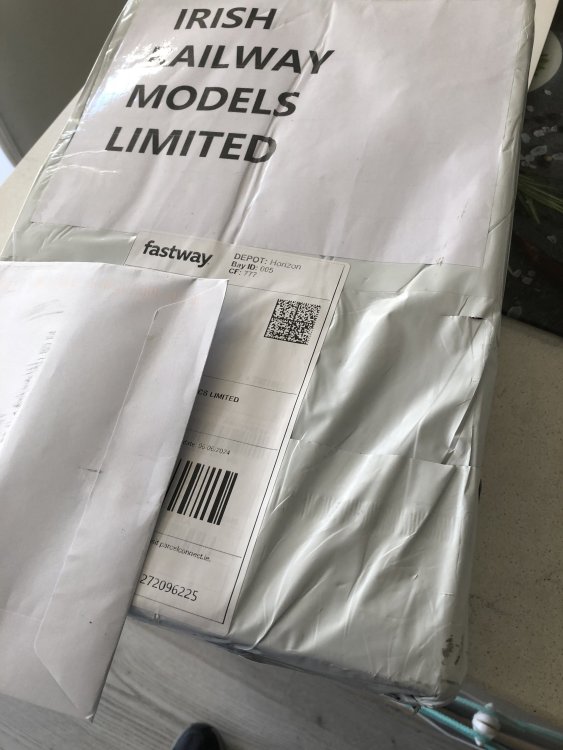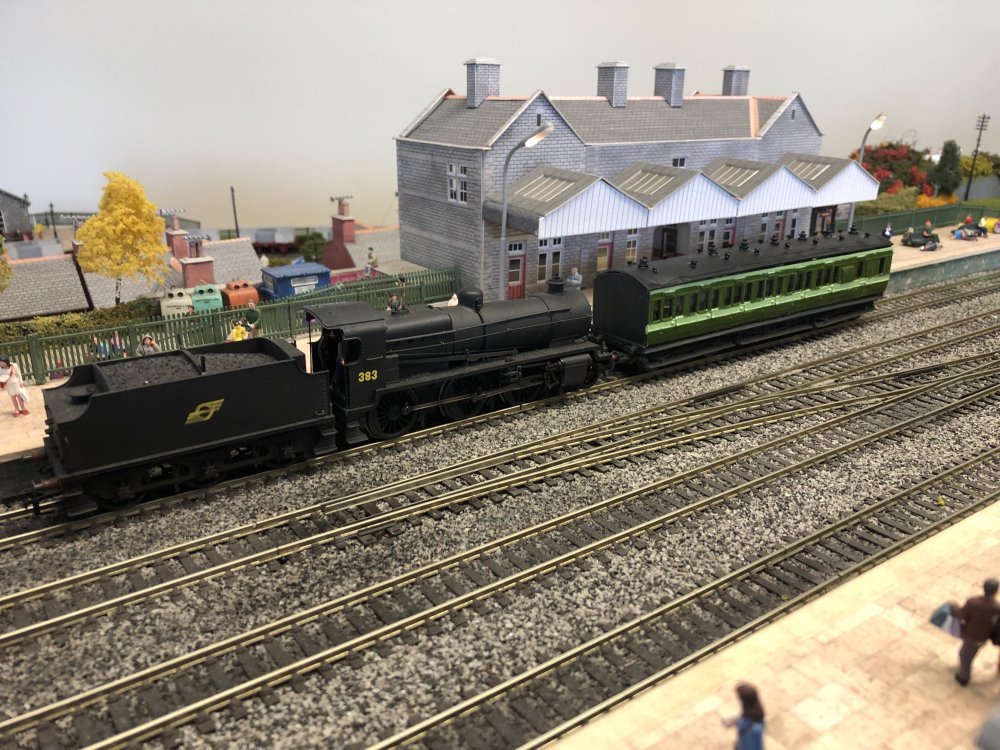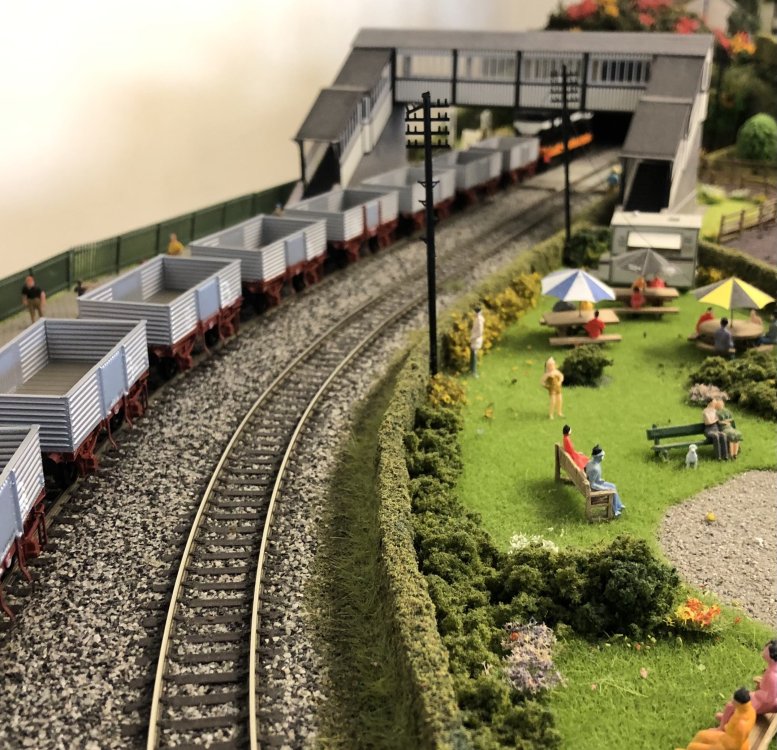-
Posts
15,810 -
Joined
-
Last visited
-
Days Won
393
Content Type
Profiles
Forums
Events
Gallery
Blogs
Store
Community Map
Everything posted by jhb171achill
-
I think they all have toilets...........
-
As a general idea of what's typically running, today we had the following: - 2-car 26 class railcar in silver & green - 071 + Taras - 121 + Cement bubbles - 201 + Mk 3s including the two Executive carriages - "A" + Cravens - 141 + Mk 2s - NIR 111 + 1990s "Enterprise" - 201 + Mk 4 set ....and an old "C" with a cattle train on the upper "0" gauge track.
-
Beagnach end: A Branchline terminus.
jhb171achill replied to Metrovik's topic in Irish Model Layouts
This is looking great! Love the rusted effects on the roof. Pure Wisht Caark'n'Kerry, boi.... And yes, the GSR had for a long time station paint scheme exactly like that, and it was continued by CIE until the early 1960s, when after a few experiments with red, the familiar multi-shaded greys took over to last to the 1980s. -
The Tooth Fairy brought a pack of the new flat wagons to my door just now…. As per the Bullied opens the other day, these are OUTSTANDINGLY GOOD. Yet again IRM have scaled new heights with what really is exhibition standard RTR Irish models. Yet again, IRM, very well done!
- 1 reply
-
- 11
-

-

-
British locos and stock that can be disguised as Irish
jhb171achill replied to Westcorkrailway's topic in Irish Models
Must say I’ve always seen the Austrians in a positive light - but like many a neighbour, they and the Germans don’t always have a high opinion of each other…. -
Do those idiots not do even the tiniest bit of elementary research? The buyer was had.
-
Yorkgate closes, York Street opens
jhb171achill replied to Darrman's topic in What's happening on the network?
Nevaaar, nevaaar, nevaaar....... (OK, it's preferable to what they have now!) -
New Murphy Models 071 Class Locos Likely in 2024
jhb171achill replied to DJ Dangerous's topic in News
County Donegal red & cream would look better than any of the dreary Enterprise liveries..............! .......Or "Ballina Goods Train Grey"! -
That's an ITG livery, though - in real life, different font on front, number on side too, and silver bogies!
-
British locos and stock that can be disguised as Irish
jhb171achill replied to Westcorkrailway's topic in Irish Models
In the 1940s, when a small Austrian man with a narrow moustache, of non-"Aryan" physique, decide to drop bombs on Belfast, the carriage sidings of the NCC were obliterated, and dozens of coaches and wagons were reduced to splinters and atoms. As a result, the (parent) LMS in Brexitstan shipped in a lot of old 1920s wooden-bodied coaches, and some wagons - both, obviously, of standard LMS / Midland Rly designs. Thus, straight repaints of several types of LMS coaches will instantly fit on an NCC / UTA / very early NIR layout as loco-hauled stock. Wagons likewise; in Tony McGartland's (truly excellent) book on the railway in Omagh, a standard LMS goods van is shown in Omagh - having deeply penetrated GNR "Derry Road" land, well away from the NCC! (Left hand side, partially seen, p67). Another is seen in the same book of standard (English) Midland design, bottom of page 91, left. A similar vehicle again in the middle of a rake, p99. The Bachmann "CIE" set some years ago, with a "Woolwich" and three coaches in 1945-55 CIE lined dark green, are in fact LMS types. While they do not remotely resemble anything that ever ran on CIE (and more than almost all British wagons do), they are perfect for some of the types used on the NCC / UTA, with a handful lasting a few years into NIR days, even appearing behind a Hunslet on a handful of Portrush excusrions. Very often, if there's a mix of scale irish coach models (e.g. SSM kits) on a layout, they stand out amongst repainted British stuff, as the latter is noticeably narrower. It looks odd, but there's a prototype for everything; in reality this was the case. Look at how narrow the RPSI's BR van looks beside its Cravens. It was even more so in the north 1945-70, in the circumstances mentioned above. The coaching stock of the NCC in its last few years, and the UTA's ex-NCC section throughout the existence of the UTA, and the last loco-hauled trains of NIR until the early 1970s, had a mixture of the following: 1. Belfast built coaches to LMS NCC design 2. The last few BNCR stock, recognisable by their flat sides 3. British-built stock, brought over and re-gauged in the 1940s to replace bomb-damaged stock, to standard LMS desings - but noticeably narrower! After 1958, add to this ex-GNR stock. And - the GNR had a very small amount of coaches that were second hand ex-British stuff too - LNWR, I think from memory. The point here, though, in relation to British stuff which is usable here, is that a number of LMS designs can be used as NCC stock in the latter yerars of this company; repaint plain maroon (unlikely to have had lining, as secondary stock), or get LMS liveried ones and remove LMS crest and "LMS" lettering. For UTA, plain green, centre line of beige (not yellow) edged in red, and UTA crest; and a handful made it into NIR plain maroon, grey roof, black ends, with a 3" pale grey waistline. Mix and match with Worsely or SSM kits and Robert is a sibling to one of your parents. Now, where's this IRM RTR Jeep? -
In the same way that nin final days, the 121 / 141 / 181 classes variously had dayglo lower panels on the front, or else didn't, in green livery days some of the A, B101 & C classes had an eau-de-nil waistline, and some didn't. If a re-run was being done, the black-roofed "Supertrain", perhaps 001 with the orange-shaded number on each end, and a green one with a waistline, would be the only two liveries not yet covered. Same with the C class and the B101s - some had the waistline, some didn't. To digress, we enthusiasts often dream up our own names for things, and also sometimes rarely use terminology that actual railwaymen used. In earlier operational days, the B101 class were usually called "Birmingham Sulzers" by loco staff.... (and no self-respecting NIR man ever referred to any type of railcar as a "fumper"!) .............................. Just edited this post to add - on the subject of the C class (hopefully an IRM project some day?), there was the very short-lived variant of one with a yellow buffer beam, and I've a notion another very briefly got an orange buffer beam. Two (at least) of the 121s got red buffer beams while still grey, and at least one 121 received grey again when it was first repainted - most went from the grey to black'n'tan at first repaint.
-
Very true; forgot them. True! In the passenger brake world, Dutch vans, and both the four and six-wheeled "tin vans", though the six-wheeled ones mightn't be commercially viable as there were only about five of them, and they rarely strayed off the Cork line, as well as being pretty short-lived. But the four wheelers were on virtually every single train in the 1960s, and many in the 70s. Wow! Steam or diesel, I wonder! What a wish-list I could dream up...........................
-
This is long overdue. For ALL freight trains prior to the late 60s, and most up to the late 70s, brake vans at the back are as essential as the loco at the front. And no matter what repaints or alterations we do, there's not a single British RTR van that looks even remotely like any that ran here ever. We've JM Design's excellent planked ones so far, and both GSWR / GSR and GNR types from Provincial Leslie, but an IRM RTR CIE one is badly needed! Several body design variations, several livery variations for different eras; bring 'em on....! Also in dire need of: Tin vans!
-
Production Complete - A First Look At Our Bulleid Open Wagons
jhb171achill replied to Warbonnet's topic in News
Correct, galvanised rather than painted. But chassis remained grey up to just the final years as in the model above. Anything in the modelling world based on real life before, say, 1985-90, will require purchase of the grey chassis ones. -
how much would it take to fix up the tralee to blenervile
jhb171achill replied to irishrailways52's topic in General Chat
I think the carriages are a long lost cause - I’d be more worried about the fate of the engine! -
I believe D&M are long defunct.
-
This is possibly posed; it is certainly not an actual train, as the carriages are of 1890s design. At that stage only three "singles" remained, and they were long gone from the main line - just shunted around Broadstone. In this view, if not posed, he's lifting an incoming up Galway / Sligo (two portions combined in Mullingar; Sligo part rearmost) out of the arrival platform.
-
Superpower on the branch local…and some of the new IRM Bullied opens in late 1980s / early 1990s sugar beet guise . The standard of these excellent wagons has to be seen to be believed… IMG_1057.mov
-
Irish Railway News ‘Enterprise Watch’
jhb171achill replied to IrishTrainScenes's topic in General Chat
....just running to catch the bus here............ -
A most unusual looking vehicle! It will look great when done...
-
Irish Railway News ‘Enterprise Watch’
jhb171achill replied to IrishTrainScenes's topic in General Chat
My understanding is that it will be ICRs. -
Received my Bullied opens today. They are absolutely stunning. The level of detail and overall realism is outstandingly good, as we would expect. Top marks, yet again, to IRM. I would snap these up if you want them, folks, as they're bound to be a top seller!
-
Irish Railway News ‘Enterprise Watch’
jhb171achill replied to IrishTrainScenes's topic in General Chat
Putting an oul crate like these things on the Enterprise service is just awful. I've made a note on the new Enterprise timetable of which services are railcar-operated, and will make sure I won't be using them. DDs only for me! -
To be fair, major work is being, or has been, undertaken in several important city termini - Galway, Limerick and Cork in particular, and more suburban stations are planned in Limerick and Cork areas.
-
Haulin' Oats! Grain Wagons Next For IRM's "Project Bulleid"
jhb171achill replied to Warbonnet's topic in News
Correct, yes. Or loaded from chutes to one side, under cover.
.png.c363cdf5c3fb7955cd92a55eb6dbbae0.png)





